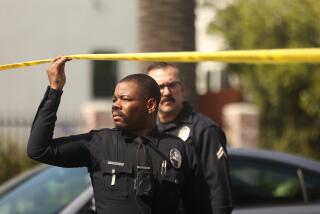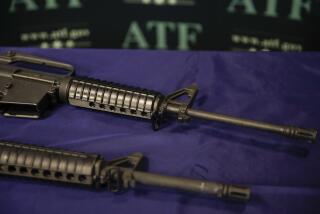Southland Firms Dominate Market for Small Handguns : Violence: Cheap weapons are favored by criminals and youths. Many are traced to serious crimes.
Southern California is home to a circle of gun makers who have virtually cornered the market in small handguns by doing it the American way--cheaper. But for thousands of crime victims across America, the products they sell are proving all too costly, a Times study shows.
Tucked away in suburban industrial complexes in and around Los Angeles County, seven arms companies have become colossal players in the market for inexpensive, small-caliber automatics, the sort that have gained favor in America’s inner cities.
Priced as low as $25, compared to $300 or more for the higher-quality handguns, the pistols produced by these firms have increasingly become the weapons of choice for criminals, crime-fearing citizens and America’s youth, accounting for a disproportionate share of handguns traced in violent crime in the United States.
In 1 out of 5 times that authorities traced a handgun involved in a murder, robbery, assault or drug crime between January, 1991, and May, 1994, the weapon was traced to these companies, according to 300,000 federal firearms records reviewed by The Times.
The companies are Davis Industries, Phoenix Arms, Lorcin Engineering, Bryco Arms, Jennings Firearms, Raven and Sundance Industries.
Officials of the companies declined to discuss the findings. They previously have cited an anti-gun bias in the news media and have said that if more of their guns are involved in crimes and traces, it reflects the high volume of their sales.
Gun industry supporters say that these firearms provide a measure of protection to law-abiding citizens who live in high-crime areas and may not be able to afford more expensive handguns.
All of these companies, records show, are, or were, owned by relatives, former business associates and family friends of George Jennings, a one-time machinist who became a millionaire after founding Raven in 1970.
Even though Raven founder Jennings is retired and does not own or control all these companies, the Federal Bureau of Alcohol, Tobacco and Firearms refers to them in official reports as “Jennings Firearms.”
In 1992, these companies manufactured roughly 80% of all small-caliber firearms in the United States, eclipsing the production of industry giants such as Colt, Smith & Wesson and Ruger.
And guns made by “Jennings Firearms” companies show up in a disproportionate number of weapons traces after murders, robberies and other violent crimes nationwide, according to a Times computer analysis of 3 1/2 years of ATF records.
The .25-caliber automatic manufactured by Raven has become the handgun most frequently seized and traced by police, while a .38-caliber automatic manufactured by Jennings’ son-in-law, Jim Davis of Davis Industries, has become the second most frequently traced handgun, records show.
During the period, guns made by “Jennings Firearms” companies were traced in connection with 2,675 assaults, 3,494 murders, 5,901 narcotics crimes and 1,223 robberies.
A number of company officials did not return calls. One member of the Jennings family said, “We’re not about to comment.”
But Richard Feldman, executive director of the American Shooting Sports Council, a legislative group that represents firearms manufacturers, wholesalers and retailers, said that if Jennings-related weapons did not exist, criminals would find some other guns to use.
“It’s easy to rail against handguns and say that just because they are inexpensive, it’s easier for the criminal to get,” Feldman said. “But what does someone making $5,000 a week selling cocaine care about how much he pays for a gun?”
Handguns manufactured in a region renowned for making movies and music have been confiscated all across America by authorities investigating serious crimes, according to ATF records.
In Sandusky, Ohio, for example, a Lorcin .380 killed a star athlete from the local high school after a fight broke out at a Halloween party.
In Milwaukee, members of a youth gang took aim at a 21-year-old man sitting on a park bench. One of the weapons: A Lorcin 9-millimeter.
In Tucson, a domestic dispute erupted, escalated, and guns were fired. The victim: a 27-year-old woman. The weapon: a Sundance .25. Also found at the scene: A Lorcin .25.
Just last weekend, two rival gangs converged on a Salt Lake City home where some gang members were having a party. One member of another gang fired a Lorcin .380, killing an 18-year-old youth.
“I’d say that 99% of our homicide shootings in Salt Lake City are Lorcins, Ravens and Jennings guns,” said police detective Jim Alcock.
The list of locales goes on: Washington. Chicago. Huntsville, Tex.
A Times review of ATF data shows:
* Since 1990, such firearms have dominated the list of handguns most frequently found at crime scenes around the nation and traced. So far this year, 6 of the 10 most frequently traced handguns in the United States were made by “Jennings Firearms” companies. The top four are Lorcin L-380, Davis P-380, Raven MP-25 and Lorcin L-25. The sixth most often traced is the Jennings J-22, and the ninth is the Phoenix-Raven.
* Of 242,106 handguns seized from crime scenes nationwide in the past 3 1/2 years and traced, 50,936, or 20%, were manufactured by these companies. By comparison, the nation’s No.1 gun manufacturer, Smith & Wesson, which has been making guns for more than a century, made 31,521 of the guns seized and traced during the same time period.
“These guys don’t manufacture anywhere near the number Smith & Wesson does,” said the ATF’s John D’Angelo, “and yet it’s their guns that show up in the traces.
* On more than 1,600 occasions, police seized and initiated a trace on a gun made by “Jennings Firearms” companies on the same day it was purchased. Authorities said this would indicate that the gun may have been used in a crime that very day. By comparison, this happened 1,041 times with Smith & Wesson guns.
* Though “Jennings Firearms” guns are manufactured here in Southern California, authorities in New York, Virginia, Michigan, Texas, Georgia, Illinois and Washington, D.C., requested traces of them more often than other states did.
“Cheap, ‘Saturday night specials’ are among the top 10 trace requests we get, and they are the ones from these companies,” said Tom Hill, a Washington-based spokesman for the ATF. “What we need to figure out is why do the guns these companies manufacture end up in the hands of criminals.”
A handful of states have outlawed several models made by “Jennings Firearms” companies as threats to public safety. Authorities say some of them could not be legally imported into the U.S. if they were made abroad because they would not meet standards for imported weapons.
Garen Wintemute, an emergency room physician and the head of UC Davis’s Violence Prevention Research Program, is author of a report to be released today on Southern California firearms manufacturers. The report says that guns made by “Jennings Firearms” companies are 3.4 times more likely to be used in crimes than are Colt, Smith & Wesson and Ruger handguns.
“They can be distinguished by their disproportionate use in crime,” he said in interview.
ATF statistics indicate that nearly 3,500 handguns made by “Jennings Firearms” companies were traced in connection with murders between 1991 and May, 1994.
*
One of them took the life of Derrick Dickey.
Last Oct. 30, in Sandusky, Ohio, a town of 30,000 on the banks of Lake Erie, an 18-year-old youth shot a popular, 17-year-old high school basketball player in the chest, killing him instantly with a .380-caliber Lorcin. Dickey had a .25-caliber Lorcin handgun in his back pocket. Police said he never reached for the unloaded weapon.
Dickey’s gun was traced to Jack’s Jewelers in Columbus, Ga. The dealer had purchased the gun in May, 1990, but when Moehling called the shop, it was out of business.
The gun Dickey’s alleged assailant used came from Norcol Gun Shop in Columbus, Ohio, and was purchased by a Sandusky youth in April, 1993, six months before the shooting. The youth told police the gun had been stolen.
“Used to be that we’d get a murder here every two or three years,” said Det. Curt Moehling, who investigated the Dickey death. “Now it’s four or five a year. And 80% are coming from the Lorcins, the Ravens and the Jennings guns.”
In Milwaukee, Jonathan Simmons, 21, was just beginning to turn his life around this summer when four members of the Black Gangster Disciples spotted him sitting on the step of a vacant corner store.
Simmons tried to run, but the four gang members fired 32 times, hitting him eight times. He had bullet wounds to his chest, thigh, leg, forearm, abdomen, calf and knee. He died at the scene on a warm summer day across the street from a playground.
Only one weapon--a 9-millimeter Lorcin pistol--was found at at the scene, although casings were found from another 9-millimeter pistol and a .40-caliber handgun.
One 16-year Milwaukee police veteran who has spent the past five years investigating homicides said the Davis, Raven and Lorcin guns pop up often in murders.
*
The “Jennings Firearms” companies date back to 1970 when George Jennings founded Raven, records show. Eight years later, his son, Bruce, formed Jennings Firearms, which in 1985 became Calwestco and in 1990 became Bryco.
In 1982, George Jennings’ son-in-law, Jim Davis, started Davis Industries, making mostly .25-caliber pistols at first.
Then, in 1989, an associate of Bruce Jennings, Jim Waldorf, established Lorcin. That same year, George Jennings’ nephew, Steve, formed Sundance Industries.
In 1991, the company that started it all, Raven, was seriously damaged by fire, and that led to the establishment of Phoenix Arms.
According to ATF figures for 1992, the latest year for which manufacturing statistics are available, the five active “Jennings Firearms” companies--Lorcin, Davis, Phoenix, Bryco and Sundance--produced 541,489 handguns of .25-, .32- and .380-caliber. That represents 81% of all such small-caliber handguns manufactured in the United States.
Times staff writer Dan Weikel, director of computer analysis Richard O’Reilly and data analyst Sandy Poindexter contributed to this article.
Tracing Firearms
Inexpensive, small-caliber handguns manufactured in Southern California can be traced to thousands of violent crimes nationwide. In crimes committed from January, 1991, to May, 1994, in which police asked the U.S. Bureau of Alcohol, Tobacco and Firearms to trace ownership of weapons, the following handguns were most often involved. Models listed with an asterisk (*) were made by Jennings-related gun companies, which dominate the small-caliber market.
Murders:
Gun type: Raven MP25*
Guns traced: 888
Gun type: Davis P-380*
Guns traced: 632
Gun type: SWD M11/9
Guns traced: 470
Gun type: Intratec Tec 9
Guns traced: 414
Gun type: Stallard/Maverick JS9
Guns traced: 403
*
Narcotics:
Gun type: Raven MP25*
Guns traced: 1,488
Gun type: Davis P-380*
Guns traced: 1,210
Gun type: SWD M11/9
Guns traced: 817
Gun type: Intratec Tec 9
Guns traced: 808
Gun type: Stallard/Maverick JS9
Guns traced: 785
*
Assaults:
Gun type: Raven MP25*
Guns traced: 601
Gun type: Davis P-380*
Guns traced: 496
Gun type: Intratec Tec 9
Guns traced: 274
Gun type: Stallard/Maverick JS9
Guns traced: 269
Gun type: Jennings J-22*
Guns traced: 262
*
Robberies:
Gun type: Raven MP25*
Guns traced: 287
Gun type: Davis P-380*
Guns traced: 260
Gun type: Stallard/Maverick JS9
Guns traced: 150
Gun type: Lorcin L-380*
Guns traced: 138
Gun type: Intratec Tec 9
Guns traced: 134
Source: Bureau of Alcohol, Tobacco and Firearms
More to Read
Inside the business of entertainment
The Wide Shot brings you news, analysis and insights on everything from streaming wars to production — and what it all means for the future.
You may occasionally receive promotional content from the Los Angeles Times.










